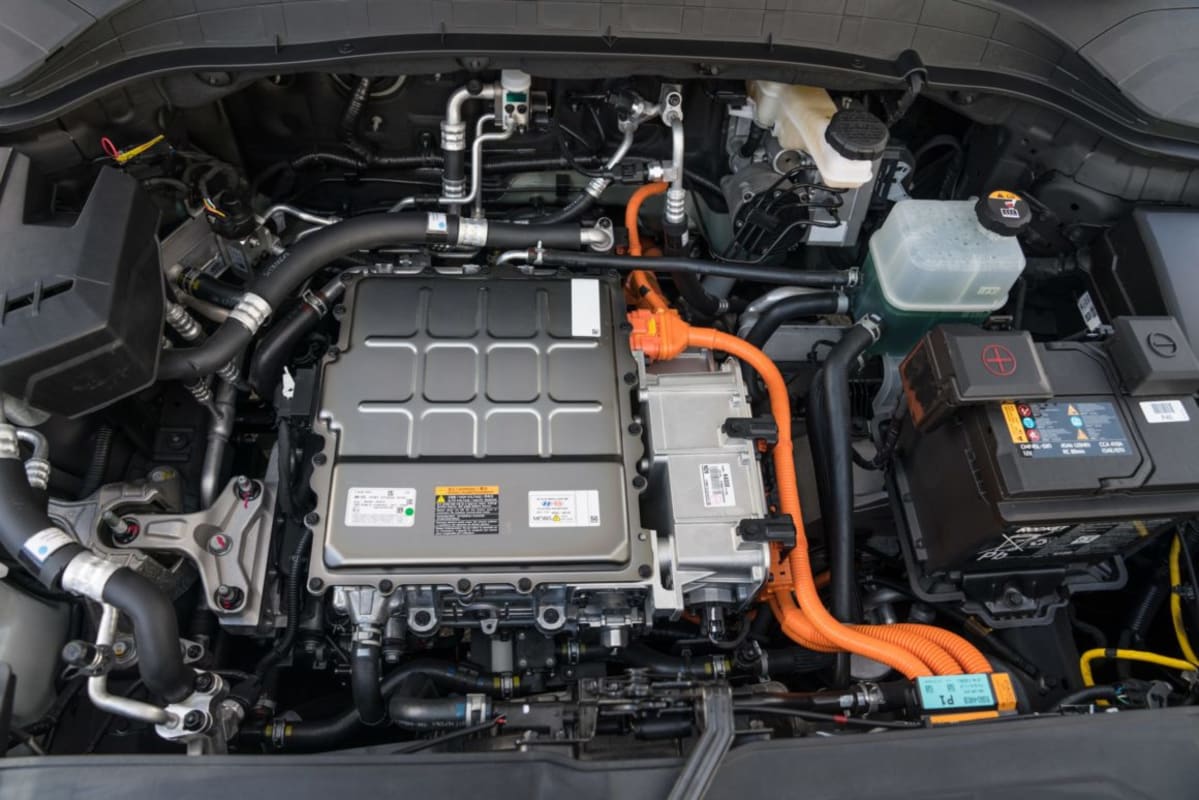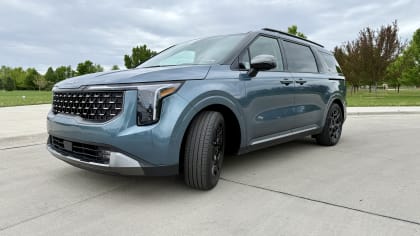The Life Altering Magic of the Kona EV
Published on Mon, Feb 18, 2019
By: Roy Nakano
Is this the Marie Kondo of the automotive world?
First of all, let’s applaud Hyundai for coming out with a $36,450 all-electric SUV with an EPA-rated range of 258 miles ($28,950 after factoring in the $7500 federal tax credit). That beats the previous top dog of affordable EVs, the $36,620 Chevrolet Bolt EV with its 238-mile range. And we’re still waiting for the $35,000 version of the Tesla Model 3 that everyone thought would be the first affordable long-range electric vehicle.
The Kona EV is not only the new top dog of the affordable electric crowd, it’s the first long range EV sold in the form of America’s current automotive darling, the crossover SUV. Chevy does try to pass off the Bolt EV as an SUV, but it’s really more a micro-minivan in its profile.

Deceptively petite
The Kona looks every bit the part of a crossover SUV. It’s not until you see it next to, say, a Toyota RAV4, that you realize how petite it is. Unlike the truncated silhouette of the Bolt, Hyundai chose to keep the proportions of a bigger SUV, but shrink-wrapped down to subcompact dimensions.
In fact, if you don’t have a vehicle next to it for comparison, you’d swear it’s bigger than it really is. The design proportions of the Kona make for an exceptionally handsome vehicle, but it does come with some sacrifices. Despite having the same wheelbase as the Bolt, the Kona has considerably less headroom and rear legroom (by around three inches in the latter category). For those that hold rear seat legroom at a premium, this will make the Kona a non-starter. On the other hand, if you don’t have a family of near-giants, the Kona may be perfectly adequate. Adjusting the driver seat in the Kona EV for my 5′ 9″ frame still provides me with sufficient legroom for sitting in the rear seat.

KonaMari cargo
Out back, the Kona provides useful cargo space. The visible space looks pretty shallow, until you realize there are two levels of hidden compartments below. This means it’s less likely you’ll need to dig through your trunk to find what you need. And, yes, KonMari followers, it means that everything will be more visible, accessible, and easy to grab and put back. A lot of thought went into designing the space so that the cargo won’t roll around, and it should prove both appreciated and useful for Kona owners.
Tidying up the suspension
One of the key differences between the Bolt EV and the Kona EV is the latter’s use of a multi-link suspension for the rear wheels. Both vehicles make use of independent suspensions up front, but the Bolt depends on a torsion beam for the rear suspension (as does the non-EV base Kona). While the Bolt’s ride on smooth roads is hard to fault, it can get a little choppy when riding over moderate road imperfections. In contrast, the Kona’s composure over rough roads, and even going up driveways, is readily noticeable.

The upgraded suspension in the Kona EV provides dividends in the handling department as well. The Kona EV will negotiate the turns with the tires more firmly planted on the road. It also helps that Hyundai chose to fit the Kona EV with lower profile tires. It’s far easier to induce tire squeal with the Bolt than the Kona EV. On the other hand, the tires seem to bring in more road noise in the cabin of the Kona EV. The Bolt is just a smidgen quieter at high speeds, and its taller tires provide a wee bit more cushion on smooth roads.
Just about every electric car excels in the low-end torque department, delivering the maximum amount of it from a standing start. The Bolt EV with its 266 pound-feet of torque gave the Volkswagen GTI a run for its money in the autocross comparison test we reported on (see “Lightning Bolt“). But the Kona EV delivers 291 pound-feet, making it even quicker out of the gate than the Bolt EV (the Bolt will catch it at the 0-60 mph mark). Even with a rolling start, it’s not hard to break the tires loose if you put the pedal to the metal. The Kona EV may look like an SUV, but it can perform like a hot hatchback.
We miss the simplicity of the Bolt’s one-pedal driving option. You can do it in a Kona EV, but it’ll require a little more effort – i.e., holding down your fingers against the left steering paddle if you want to come to a full stop. With the Bolt, you simply toggle the console shifter to L. At least the Kona EV has the ability. Many electrics don’t even offer it.

Tidying up the options list
Hyundai sells three versions of the Kona EV. The base SEL is the one that goes for $36,450. It has most of the good stuff, including Apple CarPlay and Android Auto, DC (Level 3) fast charger, Hillstart Assist Control, Forward Collision Avoidance Assist, Blind Spot Collision Warning, Driver Attention Warning, Lane Keeping Assist, Rear Cross Traffic Collision Warning, Rear View Monitor, Dual Heated Side Mirrors, and Heated Front Seats.
The $41,150 Limited package adds a power moon roof, leather seating surfaces, a power-adjustable driver seat, wireless device charging, and an auto-dimming rearview mirror with HomeLink. The $44,650 top-of-the-line Ultimate package gets you a heated steering wheel, AC-ventilated front seats, adaptive Smart Cruise Control, a heads-up display, an Infinity Premium Audio System with Clari-fi Music Restoration, and an 8-inch Touchscreen Navigation System.
The smart money is on the base model, and the fact that it already comes with DC fast charging capability, Apple CarPlay/Android Auto capability, heated seats, and most of the safe-driving enhancements makes it the bargain of the bunch. In contrast, the top-of-the-line Ultimate package forces you to pay for navigation when the car already has GoogleMaps and Waze access via its smart phone interface. With the latter app (Waze), you can tailor your GPS directions for carpool access. Alas, if you want adaptive cruise control (and the Kona EV has a good one), you’ll need to opt for the Ultimate package. But at $44,650, do you really want to be buying a Kona EV that costs more than the base Tesla Model 3 (now $42,900 as of this writing)? Well, since Tesla’s federal tax credit amount is sinking fast, maybe you do.
The view from above
One option we wish the Kona EV offered is Birds Eye View. It is on other Hyundai models, and it’s one of the more appreciated features on the Premier edition of Chevy’s Bolt EV. Using four cameras along each side of the vehicle, Birds Eye View provides an aerial shot of the car as it maneuvers into parking spaces or next to street curbs. It’s like having a camera-mounted drone over your car to help you see your car’s position in relation to the painted parking lines and curb. It’s far more useful than those markings on rearview camera monitors. We also miss the low-speed front view camera monitor from the Bolt EV Premier, but we’ll gladly trade it all for a Birds Eye View.

Invaders from Mars
Ever since the Prius burst onto the scene at the turn of the 21st century, automakers have grappled with complaints that electrified cars are too quiet. As an aid to sightless and inattentive pedestrians, vehicle proximity notification noisemakers were added to hybrid electric and full electric cars. Many automakers now offer their own versions of electric vehicle warning devices, but Hyundai may have the most remarkable one to date. The Kona EV’s Virtual Engine Sound System (VESS) emits a noise that harkens back to the haunting sand choir from the 1953 classic science fiction B movie, “Invaders from Mars“. At slow speeds in the Kona EV, the VESS changes pitch as the speed of the car changes. Once the car reaches about 20 miles per hour, the sound disappears. Within the reverberant confines of a parking garage, the VESS of an approaching Kona EV is enough to draw a double-take from nearby pedestrians. Very freaky cool, Hyundai.
But does it spark joy?
Electricity is not the only thing that sparks from the Kona EV. But really, practically all electric cars are good at generating lots of smiles. No more stop-start stutters. No more engine vibrations at all. No more gas station visits (except maybe for car washes). And you’ll have the smoothest, most linear accelerations ever. Once you experience the instantaneous response of an electric, you’ll think all internal combustion cars have turbo lag. To top it off, maintenance is almost non-existent with electrics. No engine oil or water pumps to fail, no fuel injectors, spark plugs or filters to clog, no engine radiators to leak, and no automatic transmission gears to start slipping. It all means fewer things to go wrong. And regenerative braking means the need for brake service is few and far between.
Alas, all this joy has had its limits. Just a few years ago, that limit was 84 miles in the affordable range-topping electric Fiat 500e. Today, it’s the 258-mile Kona EV that’s the affordable range topper. It’s not just four times the range of the 500e, it’s life altering in the world of EVs. It means commuting from San Gabriel Valley to Orange County, and then to LAX, and then to downtown Los Angeles and back to the Valley without needing an interim charge. For most commutes in the Southland, it means going several days without the need to charge. It’s a new day for affordable electric vehicles, and Hyundai is leading the way with the Kona EV.
For more information about Hyundai products, go to hyundaiusa.com.

THE MAIN INGREDIENTS
Name of vehicle:
2019 Hyundai Kona EV
Type of vehicle:
Front-wheel drive sub-compact crossover SUV
Prices:
$36,450 (Base – includes Apple CarPlay and Android Auto, DC (Level 3) fast charger, Hillstart Assist Control, Forward Collision Avoidance Assist, Blind Spot Collision Warning, Driver Attention Warning, Lane Keeping Assist, Rear Cross Traffic Collision Warning, Rear View Monitor, Dual Heated Side Mirrors, and Heated Front Seats)
$41,150 (Limited – includes a power moon roof, leather seating surfaces, a power-adjustable driver seat, wireless device charging, and an auto-dimming rearview mirror with HomeLink)
$44,650 (Ultimate – includes heated steering wheel, AC-ventilated front seats, adaptive Smart Cruise Control, a heads-up display, an Infinity Premium Audio System with Clari-fi Music Restoration, and an 8-inch Touchscreen Navigation System)
Federal tax credit:
Up to $7,500
California perks:
Up to $2,500 Clean Air Rebate
HOV lane single-occupant access carpool sticker eligible
Power source:
Permanent-magnet synchronous AC motor with 64.0-kWh lithium-ion battery pack, 201 horsepower and 290 pound-feet of torque at 0 rpm

EPA ratings
Driving range: 258 miles
Fuel economy: 120 MPGe
Estimated fuel savings over 5 years: $4,250
EPA vehicle size classification (based on actual interior volume):
Small SUV
Performance
0-60 mph: 7.6 seconds (manufacturer estimate)




